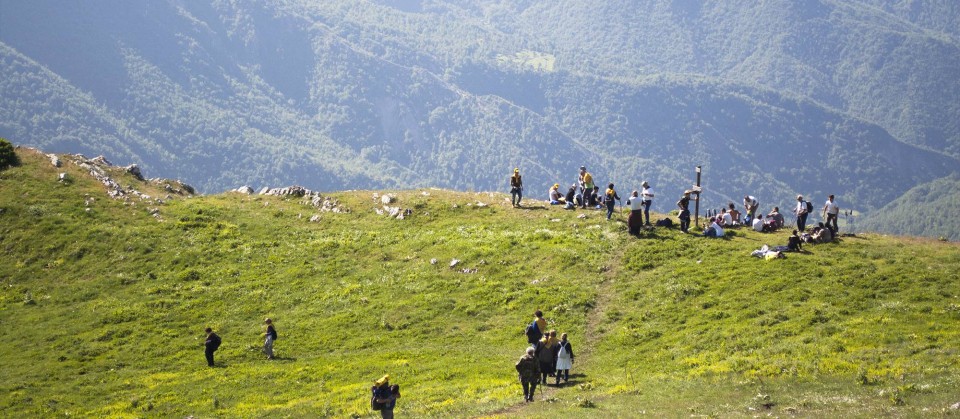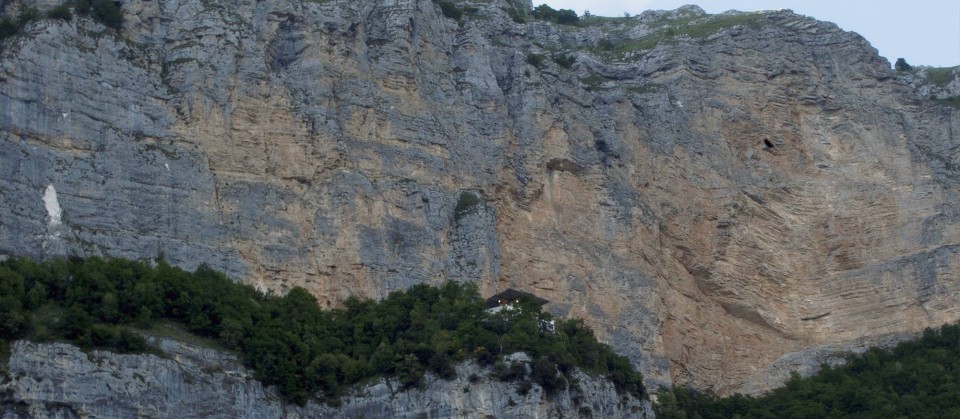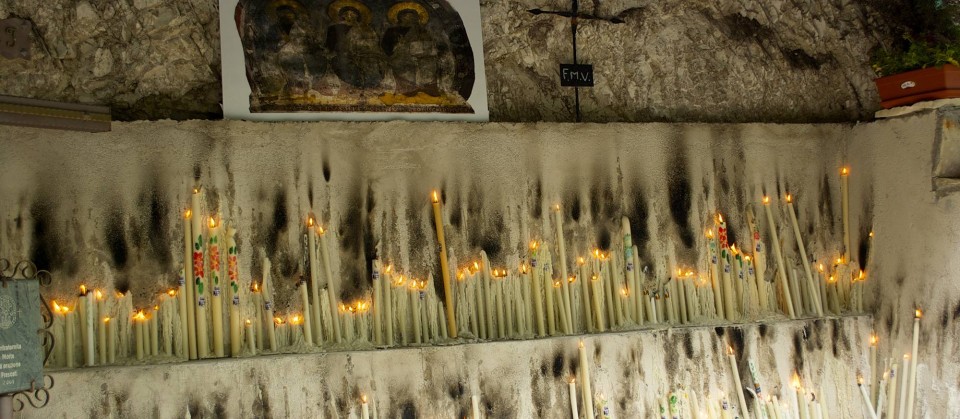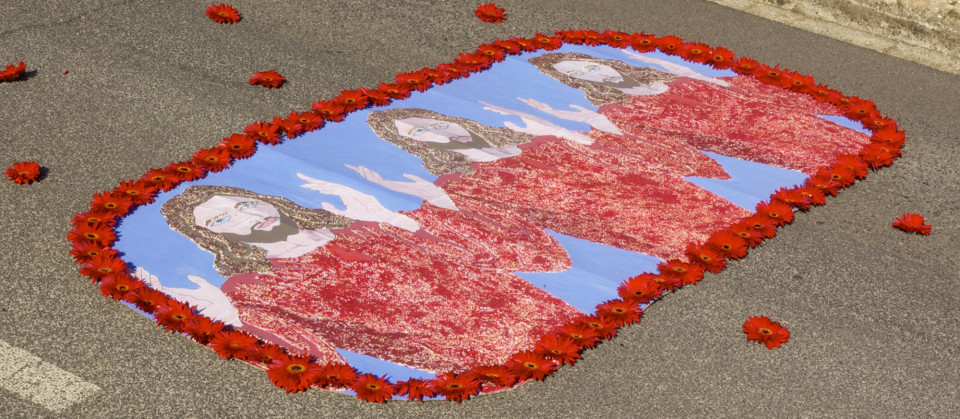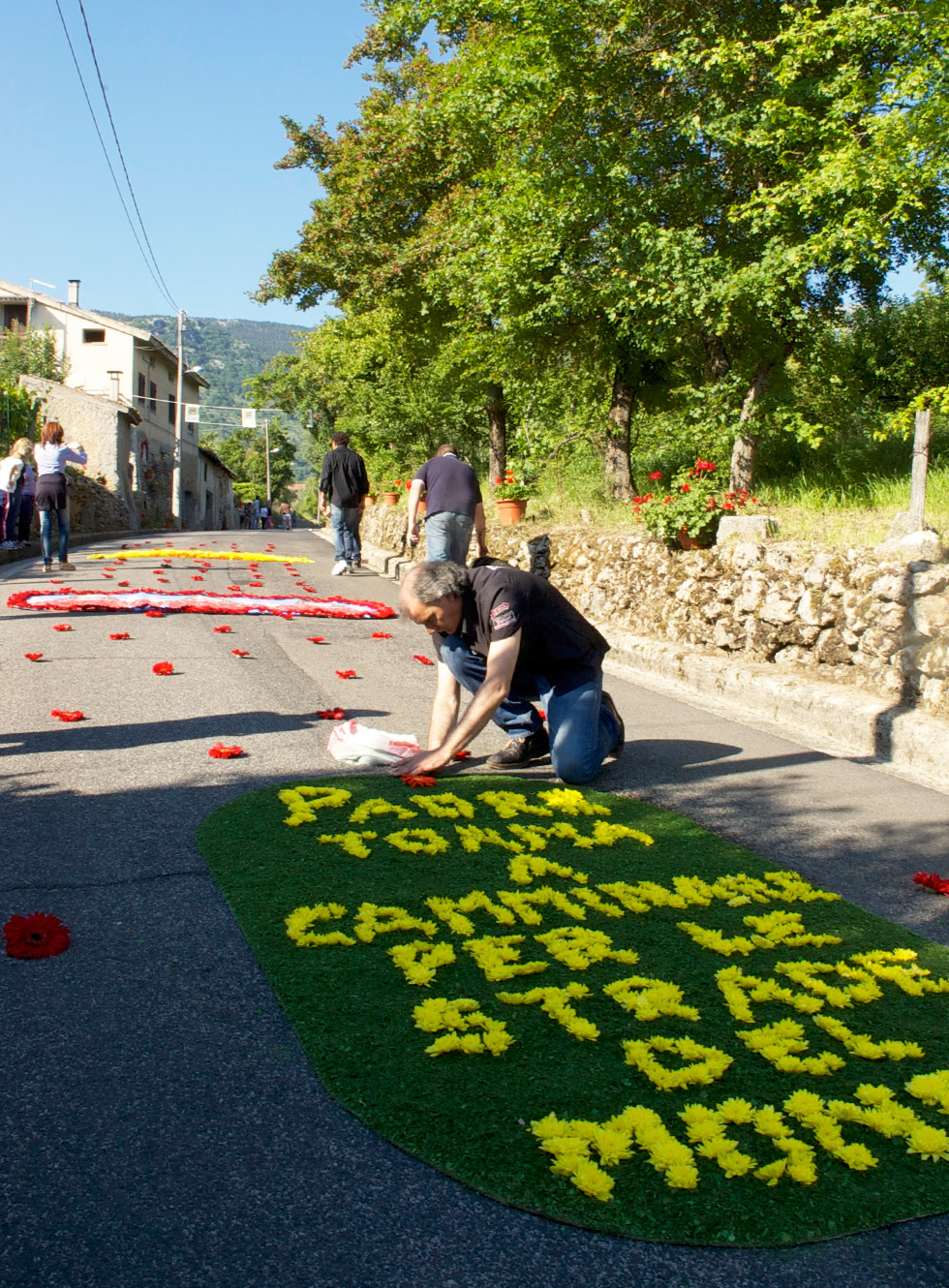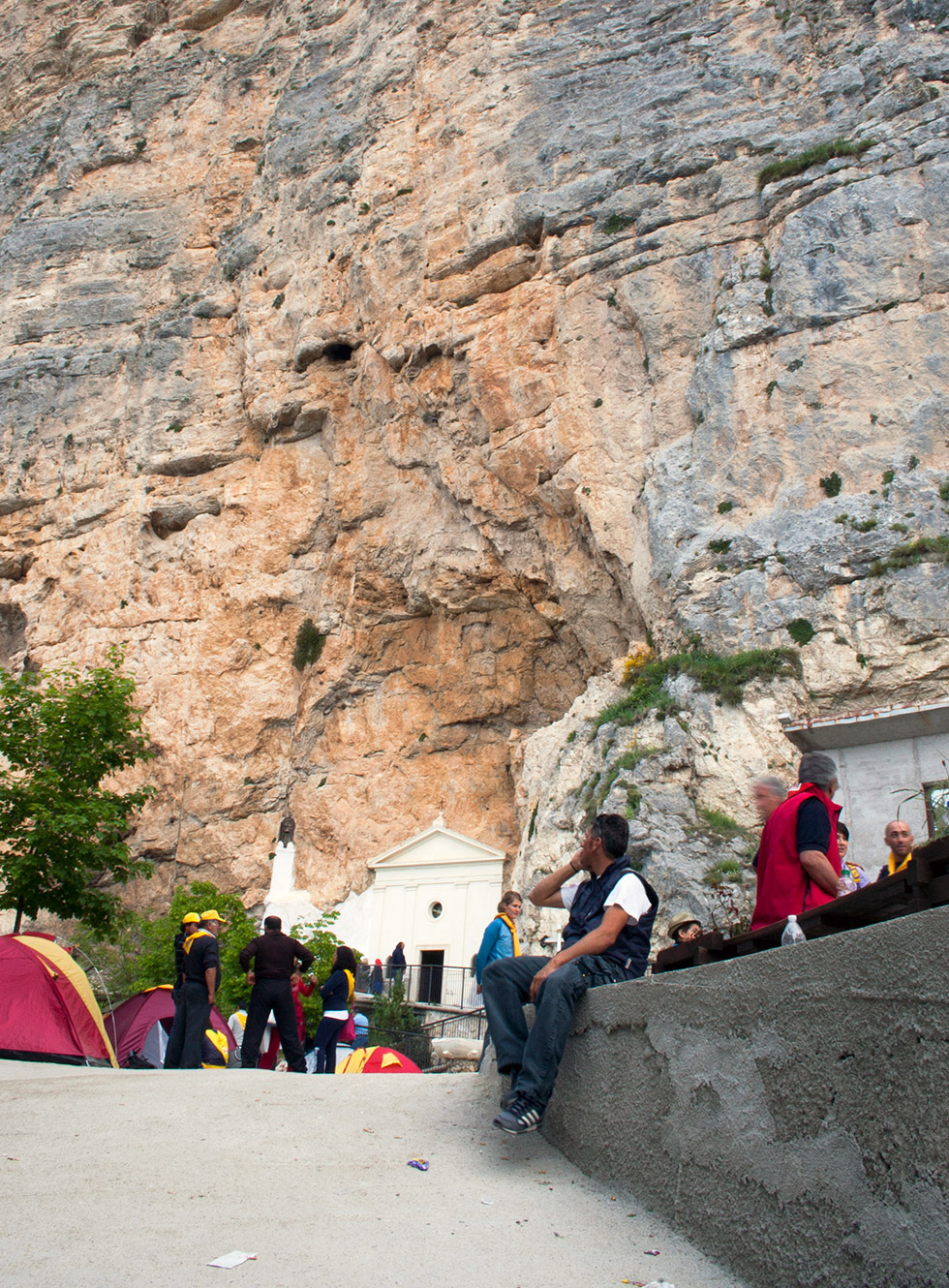సైట్
మధ్య ఇటలీలోని అతిపెద్ద ఎత్తైన ప్రాంతాలలో ఒకటి మరియు సింబ్రూని పర్వతాల ప్రాంతీయ ఉద్యానవనం నడిబొడ్డున, శాంటిస్సిమా ట్రినిటా యొక్క చిన్న పుణ్యక్షేత్రం ఉంది (చాలా పవిత్ర ట్రినిటీ). సైట్ a కింద ఉంది 300 M రాక్ ఫేస్. ఆ ఐకానిక్ ప్రదర్శన కారణంగా, ఇది క్రైస్తవ పూర్వ కాలంలో ఇప్పటికే ఆరాధన కేంద్రం. ఒక మిలీనియం కోసం, పూజలు యొక్క ప్రధాన వస్తువు పవిత్ర ట్రినిటీ యొక్క విలక్షణమైన చిత్రం, ఈ ప్రాంతంలోని అనేక గ్రొటోలలో ఒకదాని యొక్క బేర్ రాక్ మీద బైజాంటైన్ శైలిలో పెయింట్ చేయబడింది. ట్రినిటీ యొక్క వార్షిక రోజున (40 ఈస్టర్ తరువాత రోజులు), గ్రామాల నుండి వేలాది మంది వ్యాసార్థంలో 50 KM ఇక్కడ సేకరించండి. వారు మూడు రాత్రులు మరియు రోజులు ఉంటారు, వారు నిరంతరాయంగా పాడతారు మరియు ప్రార్థిస్తారు. చాలామంది చాలా రోజులు నడక లేదా గుర్రపు స్వారీకి వస్తారు, ట్రాన్స్హ్యూమంట్ పశువుల కాపరులు ఉపయోగించే మార్గాల్లో. తీర్థయాత్ర మరియు వేడుకలు పవిత్ర ట్రినిటీ ఇటలీ మరియు పశ్చిమ ఐరోపాలో జానపద భక్తి యొక్క అత్యంత నిజమైన వ్యక్తీకరణలలో ఒకటి.
బెదిరింపులు
గత పదిహేను సంవత్సరాలలో, పుణ్యక్షేత్రం చుట్టూ నిర్మించిన ప్రాంతం పదివేల వార్షిక యాత్రికులకు సౌకర్యం మరియు భద్రతను మెరుగుపరచడానికి విస్తరించబడింది. సాంప్రదాయ యాత్రికుల వార్షిక పల్స్ పక్కన, సందర్శకులు ఏడాది పొడవునా ఎక్కువగా ఆకర్షితులవుతారు, మరియు దాని మెరుగుదల ప్రాప్యత మరియు మౌలిక సదుపాయాలు. పట్టుదలతో ఉంటే, ఈ ధోరణి సైట్ యొక్క కొన్ని సహజ మరియు సౌందర్య విలువలను బెదిరించగలదు. జాతుల అధికంగా ఉండే గడ్డి భూములు మరియు ఈ ప్రదేశం చుట్టూ ఉన్న విలువైన సిల్వో-పాస్టోరల్ మొజాయిక్ల నిర్వహణ కూడా పశుసంవర్ధక మరియు పరిరక్షణ చర్యల క్షీణత ద్వారా బలహీనపడుతుంది. సాంప్రదాయిక నిర్వహణ రూపాల ద్వారా ఇవి చాలా సంవత్సరాలుగా విశేషమైన అటవీ నిర్మూలనను కలిగి ఉన్నాయి, ఉదాహరణకు వేట మరియు అండర్స్టోరీ నిర్వహణకు పరిమితులు. చివరగా, మతపరమైన ఆచారాల యొక్క కొనసాగుతున్న సాధారణీకరణ సైట్తో సంబంధం ఉన్న ప్రత్యేకమైన అసంపూర్తిగా ఉన్న సాంస్కృతిక వారసత్వానికి నష్టపోవచ్చు.
విజన్ సమీప భవిష్యత్తులో, ఇది అవసరం: (1) సైట్ యొక్క పూర్తి విలువల గురించి ప్రధాన వాటాదారులు మరియు విస్తృత ప్రజలలో ఎక్కువ అవగాహన పెంచుకోండి; (2) పరిరక్షణకు జీవ సాంస్కృతిక విధానాన్ని స్వీకరించడానికి పార్క్ అథారిటీ యొక్క ప్రస్తుత ప్రయత్నాలకు మరింత మద్దతు ఉంది; మరియు (3) సైట్ యొక్క భవిష్యత్తు కోసం భాగస్వామ్య మరియు స్థిరమైన దృష్టిని చర్చించడానికి ప్రధాన వాటాదారులను ప్రోత్సహించండి.
పరిరక్షణ పరికరములు అధికారికంగా రక్షించబడినప్పటికీ, ఈ పవిత్రమైన సహజ ప్రదేశంలో సహజ మరియు కనిపించని వారసత్వాల పరిరక్షణ మరింత చేతన విధానం నుండి ప్రయోజనం పొందుతుంది, ఉదాహరణకు ప్రేరణ పొందింది రక్షిత ప్రాంత నిర్వాహకుల కోసం ఐయుసిఎన్-యునెస్కో పవిత్ర సహజ సైట్ల మార్గదర్శకాలు. మొదటి దశగా, అప్పటి నుండి నిర్దిష్ట పరిశోధన జరిగింది 2010, పర్యావరణ ద్వారా సైట్ యొక్క జీవ సాంస్కృతిక ప్రత్యేకతను అర్థం చేసుకోవాలనే లక్ష్యంతో (ఫ్లోరిస్టిక్ సర్వేలు, ప్రాదేశిక విశ్లేషణ) మరియు సోషల్ సైన్స్ పద్ధతులు (పాల్గొనేవారి పరిశీలన, ఎథ్నోగ్రాఫిక్ ఇంటర్వ్యూలు, ఫోకస్ గ్రూపులు).
ఫలితాలు ఇప్పటివరకు పూర్తయిన పరిశోధన పని ప్రాంతం యొక్క పర్యావరణ విలువల యొక్క పరస్పర ఆధారపడటానికి మరియు తీర్థయాత్ర మరియు జంతువుల పశువుల పెంపకం వంటి సాంప్రదాయ కార్యకలాపాలకు రుజువు చేసింది. భవిష్యత్ పరిణామాల గురించి స్థానిక ప్రజల కొన్ని ప్రాధాన్యతలు మరియు దృక్పథాలు సేకరించబడ్డాయి. ఈ ప్రయత్నాలు పుణ్యక్షేత్రంతో సంబంధం ఉన్న అసంపూర్తిగా ఉన్న వారసత్వం యొక్క ప్రత్యేకతను హైలైట్ చేశాయి, పరిరక్షణకు జీవ సాంస్కృతిక విధానం కోసం దావాకు మద్దతు ఇస్తుంది. సైట్ నిర్వహణ మరియు పాలనపై చర్చలను తెలియజేయడానికి ఈ అంతర్దృష్టులు విస్తరిస్తున్నాయి, మరియు సమీప భవిష్యత్తులో సంకీర్ణ నిర్మాణ ప్రక్రియలను సిద్ధం చేయండి.
ఎకాలజీ మరియు జీవవైవిధ్యం
కార్స్ట్ రాక్ నిర్మాణాలు మరియు మందపాటి బీచ్ ఫారెస్ట్ సైట్ను వర్గీకరిస్తాయి, ఇది ఈ ప్రాంతంలో అతి ముఖ్యమైన వాటర్కోర్స్కు మూలం, సింబ్రివియో నది. చుట్టుపక్కల పీఠభూములలో, జంతువుల పశువుల పెంపకం ద్వారా సృష్టించబడిన జాతులు అధికంగా ఉండే గడ్డి భూములు అప్పుడప్పుడు అడవికి అంతరాయం కలిగిస్తాయి. అత్యంత పురాతన చెట్లు, తరచుగా పొలార్డెడ్ లేదా అదేవిధంగా నిర్వహించబడుతుంది, ఈ గడ్డి భూముల పాచెస్లో కనిపిస్తాయి. యొక్క అరుదైన జనాభా ఎరియోఫోరం లాటిఫోలియం పుణ్యక్షేత్రం పైన ఉన్న రాతి ఆవాసాలలో పెరుగుతుంది. తోడేళ్ళు కొత్తగా ఈ ప్రాంతాన్ని తిరిగి ప్రారంభించాయి.
సంరక్షకులు పుణ్యక్షేత్రం అనగ్ని యొక్క బిషోప్రిక్ పరిధిలో ఉంది, ఇది అపోజిట్ పూజారిని నియమిస్తుంది (రెక్టర్) దీన్ని పర్యవేక్షించడానికి. ది రెక్టర్ ప్రారంభ వ్యవధిలో ఆన్-సైట్ నివసిస్తుంది (మే నుండి అక్టోబర్ వరకు) మరియు పుణ్యక్షేత్రం యొక్క నిర్వహణ మరియు మత ఉపయోగాలను పర్యవేక్షిస్తుంది. స్థానిక ప్రజల సోదరభావం ప్రధాన వేడుకలను నిర్వహించడంలో గణనీయమైన పాత్ర మరియు స్వాతంత్ర్యం కలిగి ఉంది, మరియు సైట్ నిర్వహణలో ప్రత్యక్ష వాటా. బ్రదర్హుడ్స్ తరువాతి వారితో మరింత సన్నిహితంగా ఉన్నాయి, సమీప గ్రామం, మరియు సుబియాకో, ఒక పట్టణం ఉన్న పట్టణం పవిత్ర ట్రినిటీ ఏడాది పొడవునా సంక్లిష్టమైన ఆచారంగా అనువదిస్తుంది. అధికారిక పరిమితులు లేనప్పటికీ, బ్రదర్హుడ్స్కు అనుబంధం సాధారణంగా వారసత్వంగా మరియు, సుబియాకో విషయంలో, ఇటీవల వరకు పురుషులకు పరిమితం చేయబడింది. పుణ్యక్షేత్రం చుట్టూ ఉన్న పీఠభూములు స్థానికంగా యాజమాన్యంలోని సిల్వో-పాస్టోరల్ సామూహిక లక్షణాలు. సాంప్రదాయ ఆర్థిక కార్యకలాపాల క్షీణత మరియు వనరులపై ఒత్తిడి తగ్గడం, కొన్ని దశాబ్దాలుగా వార్షిక రుసుములకు బదులుగా వారు బయటివారికి కూడా అందుబాటులో ఉన్నారు.
కలిసి పనిచేయడం ప్రస్తుతం, సైట్ యొక్క పాలన సాపేక్షంగా విచ్ఛిన్నమైంది. సహకార చర్య కోసం ప్రయత్నాలు ఉన్నప్పటికీ, ప్రధాన వాటాదారులందరూ పంచుకున్న ఏకాభిప్రాయ దృష్టి ఇంకా లేదు, అంటే, స్థానిక ప్రజలు, నిర్వాహకులు, చర్చి, మరియు పార్క్ నిర్వహణ. గ్రామీణాభివృద్ధిని ప్రోత్సహించడం సృష్టి సమయంలో పార్క్ యొక్క ప్రధాన లక్ష్యం అని నిర్వచించబడింది. అయితే, సాంప్రదాయ స్థానిక వారసత్వంపై తక్కువ శ్రద్ధ చూపబడిందని స్థానిక ప్రజలు పేర్కొన్నారు, మరియు పరిపాలనా కుంభకోణాల కారణంగా సందేహాలలో సంశయవాదం పెరిగింది. మొత్తంమీద, ప్రధాన వాటాదారులు ప్రధానంగా వారికి ముఖ్యమైన నిర్దిష్ట విలువపై దృష్టి సారించినట్లు అనిపిస్తుంది, కానీ ఇంటర్లింక్డ్ ఆధ్యాత్మికంపై సమగ్ర దృష్టి ఉన్నట్లు అనిపించదు, సైట్ యొక్క సాంస్కృతిక మరియు పర్యావరణ విలువలు.
విధానం మరియు చట్టంపై ఈ ఉద్యానవనం లాజియో యొక్క ప్రాంతీయ చట్టంతో సృష్టించబడింది 1983 మరియు పాక్షికంగా యూరోపియన్ నాచురాతో అతివ్యాప్తి చెందుతుంది 2000 నెట్వర్క్. ఇది సుమారు 300 కి.మీ 2 విస్తీర్ణంలో ఉంటుంది, పొరుగు ప్రాంతాలకు చెందిన ఎత్తైన ప్రాంతాలతో సహా కాదు (అబ్రుజ్జీ). నాచురా అమలు చేసిన మరియు ప్రోత్సహించిన కనీస జోక్య నిర్వహణ ‘ప్రకృతి కోసం’ 2000, ఈ ప్రాంతంలో సాంస్కృతిక ప్రకృతి దృశ్యాల పరిరక్షణను ఆప్టిమైజ్ చేయడానికి సరిపోదు. ఈ నిర్వహణ విచక్షణారహితంగా అన్ని ఆవాసాలకు ‘సహజత్వం’ అనే ఆలోచనను వర్తిస్తుంది, మరియు సాంప్రదాయ ఉత్పాదక పద్ధతుల యొక్క ప్రాముఖ్యతను గుర్తించలేదు (పాస్టోరలిజం వంటివి, స్థిరమైన వ్యవసాయం, మరియు అండర్స్టోరీ మేనేజ్మెంట్) జీవ విలువలను సృష్టించడంలో. స్థానిక సమూహాలు, జంతు పశువుల కాపరులు వంటివి, నిర్ణయం తీసుకునే యంత్రాంగాలలో తక్కువ స్వరం కలిగి ఉండండి, కీలక సాంప్రదాయ కార్యకలాపాలకు ప్రాతినిధ్యం వహించినప్పటికీ. ఇతర ఆటగాళ్ళు, చర్చి వంటివి, ప్రాంతీయ లేదా జాతీయ ప్రాధాన్యతల ద్వారా నడిచే నిర్దిష్ట ఆసక్తులు ఉన్నాయి. అందువలన, రక్షిత ప్రాంతాల IUCN వర్గం V నుండి ప్రేరణ పొందిన నిర్వహణ పాలనలు మరింత సముచితమైనవిగా కనిపిస్తాయి.
నీవు వైపు కళ్ళు తిరిగావు దాహం ద్వారా మనిషిని అణచివేస్తాడు మరియు వెంటనే రాళ్ళు అన్ని సత్యంలో నీటిని పోసింది - సాంప్రదాయ పాట శాంటిస్సిమా ట్రినిటాను ప్రశంసించింది.
- ఫ్రాస్కారోలిలో వాతావరణం, ఎఫ్., భగవత్, ఎస్, గ్వారినో, ఆర్., వైటర్క్, A., ష్మిడ్, బి. (ప్రెస్లో) మధ్య ఇటలీలోని పుణ్యక్షేత్రాలు మొక్కల వైవిధ్యం మరియు పెద్ద చెట్లను పరిరక్షించాయి. ఆశయం.
- ఫ్రాస్కారోలిలో వాతావరణం, ఎఫ్., Verschuuren, బి. (2016) జీవ సాంస్కృతిక వైవిధ్యం మరియు పవిత్ర స్థలాలను అనుసంధానించడం: యూరోపియన్ ఫ్రేమ్వర్క్లో ఆధారాలు మరియు సిఫార్సులు. లో: అగ్నోలెట్టి, M., ఇమాన్యుయేల్, ఎఫ్. (eds.) ఐరోపాలో జీవ సాంస్కృతిక వైవిధ్యం, చం: స్ప్రింగర్ వెర్లాగ్, p. 389-417.
- ఫ్రాస్కారోలిలో వాతావరణం, ఎఫ్., భగవత్, ఎస్, డైమెర్, M. (2014) జంతువులను నయం చేయడం, ఫీడింగ్ సోల్స్: మధ్య ఇటలీలోని పవిత్ర ప్రదేశాలలో ఎథ్నోబోటానికల్ విలువలు. ఎకనామిక్ బోటనీ 68: 438-451.
- ఫ్రాస్కారోలిలో వాతావరణం, ఎఫ్. (2013) కాథలిక్కులు మరియు పరిరక్షణ: మధ్య ఇటలీలో జీవవైవిధ్య నిర్వహణ కోసం పవిత్ర సహజ ప్రదేశాల సంభావ్యత. మానవ పర్యావరణ శాస్త్రం 41: 587–601.
- ఫెడెలి బెర్నార్డిని, ఎఫ్. (2000) ఎవరూ చంద్రుని లేని భూమికి వెళ్ళరు: ఎథ్నోగ్రఫీ ఆఫ్ ది తీర్థయాత్ర టు ది అభయారణ్యం ఆఫ్ ది హోలీ ట్రినిటీ ఆఫ్ వాలెపియెట్రా. టివోలి: రోమ్ ప్రావిన్స్.

